Part Number: DLP3030-Q1
The PGU red light has obvious jitter under low brightness setting. What might be the cause?
The setting is:
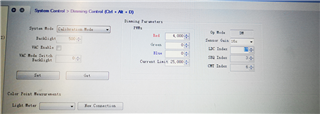
The phenomenon is:
Looking forward to your reply.
This thread has been locked.
If you have a related question, please click the "Ask a related question" button in the top right corner. The newly created question will be automatically linked to this question.
Hello User,
Thank you for bringing this information to us. Please allow us some time to look into reasons for the behavior. Thank you for your patience.
What version of the FW do you have for this system? Does this behavior occur with the LEDs?
Regards,
John
Hi,
Thanks for reaching out to the E2E forums with your question.
Are you using one of the built in test patterns or images to display the content shown in the video?
Is this a system that has been fully calibrated?, when you are in normal mode and not calibration mode and put on a red test pattern and set the brightness to a low value do you also see these issues?
Thanks,
Alex Chan
Thank you for your reply.The picture in this phenomenon is the "Splah 001" setting used. "Splah 001" is a built-in test picture.
This system had been fully calibrated.
This phenomenon also occurs in the red test pattern under low brightness in normal mode.
Thanks.
Hello User,
Thank you for the feedback. We will look over it and see if we need more information from you. Thank you for your patience.
Regards,
John
Hi,
Do you see this with other colors like all green or all blue or an all white image or just with red?
Do you have access to an oscilloscope?
Thanks,
Alex Chan
Hi,
Please probe TP7 which is the photodiode output signal.
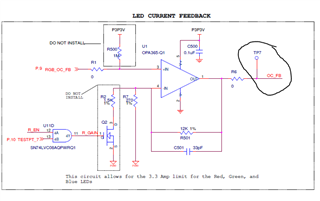
This will basically be pulses for the colors, red, green, and blue.
You can then probe for example the red enable signal in this case TP20 to see which pulses are red.
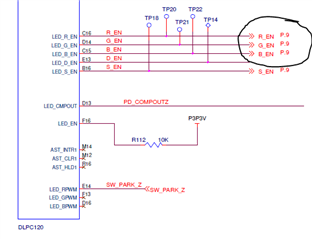
For example the yellow waveform at the bottom may be what you see from TP7.
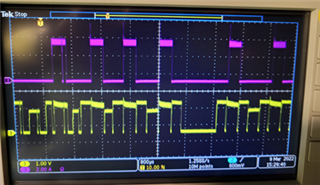
The pulse shapes will change at higher brightness's compared to lower brightness's because we have different current modes and you will see continuous pulses of light shift to discontinuous distinct pulses of light.
If you could look at the pulse shapes at the low light level where you see the jitter and send pictures that could be helpful for me to debug. I will also try to capture some on a working system in the TI lab to compare and contrast.
Thanks,
Alex Chan
Hi,
The pulse shapes image of jitter I can observe is as follows:
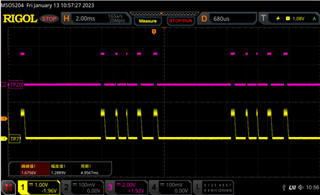
The red waveform shows the signal from TP20, and the yellow waveform shows the signal from TP7.
The specific PWMs setting of the signal is consistent with the first picture in the question.
Thanks
Hi,
Could you please send me this information the system information from your DLPC120 Automotive Control Program.
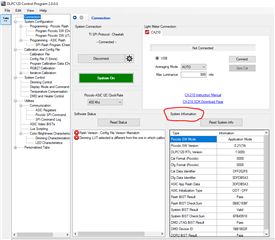
Could you also provide this information for what backlight value you are testing?

Additionally, sorry could you please probe TP6 instead of TP7.
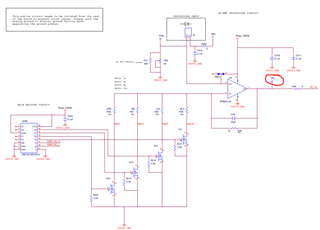
Please zoom in and check the shapes of the pulses. Can you send pictures of what the pulses look like at the lower brightness setting you are seeing the flicker and perhaps compare to other brightnesses.
For example on a TI EVM in the lab at backlight of 1000 for the all red test image, I am seeing pulses of the following shape.
Thanks,
Alex Chan
Hi,
What image are you displaying when taking these measurements? I ask because from the waveform, it looks like there are no pulses of red color being performed because when the red waveform TP20 is high, there are no yellow pulses. Since TP20 is the red enable signal, only pulses for red color should show up when the red enable signal TP20 is high.

You can check the other colored enable test points. Can you also zoom into the pulses? I am not sure what that small spike is but that does not look normal.
I will also need some time to look into this further on a TI system in the lab later this week thank you for your patience.
Thanks,
Alex Chan
Hi,
The picture in this phenomenon is the "Splah 001" setting used. It is shown as follows:

I re-measured and obtained the waveform image. The backlight value is also set to 50. The yellow waveform shows the signal from TP6, and the blue waveform shows the signal from TP20.
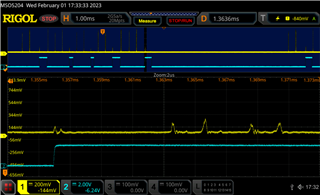
The enlarged waveform is the waveform picture of TP20 enable high.
Thank you for your replies and help.
Thank you for the information. Please allow the team some time to review and come back to you.
Regards,
John
Hi,
Are you using a TI EVM/system or did you build a system based on the TI reference design?
The shape of the pulses in the waveform that you sent do not look very good or uniform.
Here is an image I took with an all red test pattern set to backlight level 50, on my system I do not have access to that splash image. The pulses are the same shape and uniform. The pink is the red enable TP20 and yellow is TP6 which is the photodiode signal.

Additionally here are the system settings. One thing I had noticed is in your system settings the red value seemed very low compared to the green and blue. This may be ok given PWM values are subjective to each individual system. You had said your system was calibrated right? Was the system calibrated by you?

Thanks,
Alex Chan
Hi,
The board I use is a set of system based on TI reference design. The calibration I do is only for white balance calibration on a set of systems that can be operated. The result is that when LDC=18 and sensor gain=16x, the LED light flashes. In fact, not only the red light flickers, but also the green light can be observed.
As shown in the following figure, there is flicker when the value is set:

In theory, the PWM value set is large enough. But it seems that as long as sensor gain=16x is set, it will flicker.
Do I need any other calibration besides white balance?When you set the same setting value as the above figure, is the pulse shape the same and uniform? Do I need to find the cause of flicker from the direction of uneven waveform?
Thank you for your replies and help.
Hi,
Can you provide me your calibration project to look over.
With calibration everything from photodiode placement to LED variation can play a part so one system's PWM values for a certain backlight can definitely be different from another systems. Potentially photodiode placement may not be good and so it may not be getting good signal from LEDs and at very low brightness, the photodiode feedback signal may be weak causing flicker is one possibility.
Perhaps you could not use any coarse combinations with gain = 16x in calibration. For example if these are the LDC combinations ran during calibration. Remove these and see if you can still achieve your target brightness minimum.

Perhaps we can take this conversation to email instead of e2e. Is there an appropriate email I can reach out to you with? Have you had your schematic and design reviewed by TI in the past?
Thanks,
Alex Chan
Hi, my calibration project is shown below:


I also tried to exclude gain=16x from the calibration operation, but the low light also flickered when gain=8x was running.
Because in the case of gain=1x, the dimming range of the red light is very limited, and the effective dimming range cannot be obtained, so the setting of gain=1x is abandoned. Could this also be related to PD location?
We are also trying to research the impact of changing PD location. Do you have any suggestions about PD location?
Thank you for your replies and help.
Hi,
It may well be related to PD location as it is strange that gain = 8x will also have some flicker. Yes, gain = 1x will not be appropriate for lower dimming ranges so it makes sense we need some higher gain values.
Please see the attached document which goes over photo diode placement.
1067.2514478_PD_App_note_RevA (1).pdf
I have also attached the calibration user guide if you have not seen it already. It has some good instructions as well.
7180.DLPU066_Calibration_User_Guide_March2018 (3).pdf
Thanks,
Alex Chan